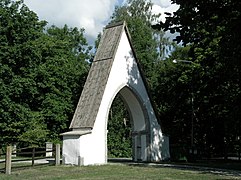
Visby Cathedral, formally Visby Saint Mary's Cathedral is a cathedral within the Church of Sweden, seat of the Bishop of Visby. It lies in the centre of Visby, the main town on the Swedish island Gotland. It was built as the church of the German traders in the city during the 13th century. The very first church was probably a wooden church, which was later replaced by a stone building. Originally built as a basilica, it was successively expanded and rebuilt during the Middle Ages. At the end of this period it had been transformed to a hall church, which it still is. In 1361, Gotland and the church became part of Denmark. Following the Reformation, it was the only medieval church in the city left in use, and in 1572 raised to the status of cathedral. Since 1645 Gotland and the cathedral have been part of Sweden. A major renovation was carried out in 1899–1903 under the guidance of architect Axel Haig.
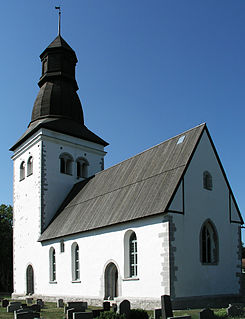
Ala Church is a medieval church in Ala on the Swedish island of Gotland. Its oldest parts date from the 12th century. Damaged by fire in the 1930s, it still contains medieval murals and its original baptismal font. The church belongs to the Church of Sweden and lies within the Diocese of Visby.

Alva Church is a medieval church in Alva on the Swedish island of Gotland. The oldest parts of the church date from the late 12th century; with the halted construction of the tower about a century later, building activity ceased. The church contains medieval murals as well as a number of medieval furnishings and pieces of art. It lies in the Diocese of Visby of the Church of Sweden.

Lye Church is a medieval church on Gotland, Sweden. The oldest parts of the church date from the last quarter of the 12th century, and the last major addition was the disproportionately large chancel, built during the second quarter of the 14th century by a workshop known by its notname as Egypticus. The workshop was also responsible for constructing the largest of the church portals, which is also decorated with Gothic stone sculpture. The tower portal contains sculptures attributed to the Romanesque sculptor Sigraf. The church has been little altered since the end of the Middle Ages. Lye Church contains the largest preserved set of medieval stained glass windows in the Nordic countries, and its interior is also decorated by medieval wall paintings, uncovered in the 1950s. The altarpiece is from 1496, and the church also contains a triumphal cross from the same period.
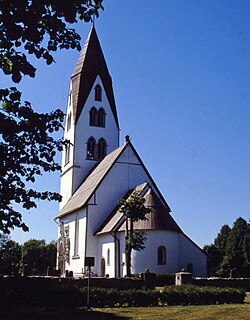
Stånga Church is a medieval church in Stånga on the Swedish island of Gotland. The site of the church has probably been considered sacred since before the Christianization of Scandinavia.

Eke Church is a medieval church in Eke on the Swedish island of Gotland. The church was built during the 12th and 13th century, with only smaller additions and changes made later. Inside, several medieval murals survive. The church is used by the Church of Sweden and lies in the Diocese of Visby.
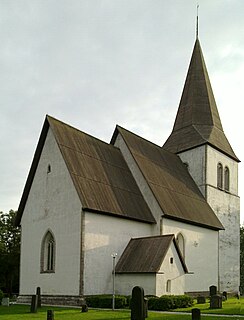
Etelmhem Church is a medieval church on the Swedish island of Gotland. The largely Gothic church contains medieval murals and a 12th-century baptismal font by the sculptor Hegvald. The church is used by the Church of Sweden and part of Diocese of Visby.

Lärbro Church is a medieval church in Lärbro on the Swedish island of Gotland. The church is located at a former strategically important spot, as testified by the adjacent fortified tower. The presently visible Gothic church replaced an earlier Romanesque church during the 13th and 14th century. The cemetery of the church contains several graves of victims from Nazi concentration camps who were taken to a field hospital in Lärbro during and after World War II.

Buttle Church is a medieval church in Buttle on the Swedish island of Gotland. It is one of the more well-preserved Romanesque churches on Gotland, and contains both a number of medieval furnishings as well medieval murals. Buttle Church belongs to the Diocese of Visby of the Church of Sweden.

Bäl Church is a medieval church in Gute, Bäl, on the Swedish island of Gotland. It was built during the first half of the 13th century and contains sculptural decoration in both Romanesque and Gothic styles. The interior is decorated by medieval wall paintings. It belongs to the parish Väskinde, in the Diocese of Visby.

Dalhem Church is a medieval church in Dalhem on the Swedish island of Gotland. Built in the 13th and 14th century, the church underwent major changes during a renovation at the turn of the 19th–20th centuries. Dalhem Church lies in the Diocese of Visby of the Church of Sweden.

Ekeby Church is a medieval church in Ekeby on the Swedish island of Gotland. The oldest parts date from the 12th century, and the church has been little altered since the end of the 13th century. Its interior is richly decorated with medieval murals. It belongs to the Church of Sweden and lies in the Diocese of Visby.

Endre Church is a medieval church in Endre on the Swedish island of Gotland, in the Diocese of Visby, built from the 12th to early 14th century. It contains medieval murals and several medieval furnishings, and belongs to the Church of Sweden.

Fleringe Church is a medieval church in Fleringe on the Swedish island of Gotland. Although heavily damaged by fire in 1676, medieval mural fragments survive in the church, which also still has its medieval lychgate and preserved church stables. The church is associated with the Diocese of Visby of the Church of Sweden.

Levide Church is a medieval church on the Swedish island of Gotland. It lies in the Diocese of Visby.
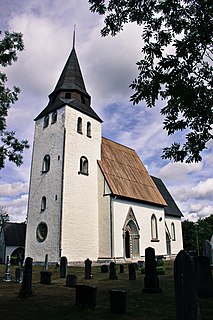
Norrlanda Church is a medieval church on the Swedish island Gotland, in the Diocese of Visby.

När Church is a medieval church on the Swedish island Gotland. It belongs to the Church of Sweden and lies in the Diocese of Visby.

Vallstena Church is a medieval church on the island of Gotland, Sweden. It belongs to the Diocese of Visby.

Othem Church is a medieval church in Othem on Gotland, Sweden. It was built in the 13th century and contains several medieval murals.







